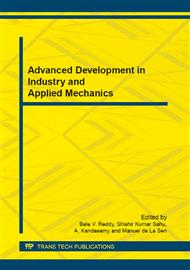[1]
NHTSA. TRAFFIC SAFETY FACTS 2011. Tech. Rep. DOT HS 811 753, U.S. Department of Transportation (2011).
Google Scholar
[2]
M. Jinlai, W. Bofu, C. Jie. Comparisons of 4WS and Brake-FAS based on IMC for vehicle stability control, Journal of Mechanical Science and Technology 2011; 25 (5): 1265-1277.
DOI: 10.1007/s12206-011-0309-z
Google Scholar
[3]
M. Roberts, T. Chhaya. An approach to the safety design and development of a brake-by-wire control system. in: 2011 SAE International, Singapore, 2011, pp.2011-0212.
DOI: 10.4271/2011-01-0212
Google Scholar
[4]
W. Xiang, P. C. Richardson, C. Zhao. Automobile brake-by-wire control system design and analysis, Vehicular Technology, IEEE Transactions on 2008; 57 (1): 138-145.
DOI: 10.1109/tvt.2007.901895
Google Scholar
[5]
S. Raman, B. S. Khannan, M. V. Mahalingam. Beyond ABS - Brake by Wire Development of a Working Concept. in: 2003 SAE International, Pune, India, 2003, pp.2003-0010.
DOI: 10.4271/2003-28-0010
Google Scholar
[6]
J. K. Ahn, K. H. Jung, D. H. Kim. Analysis of a regenerative braking system for hybrid electric vehicles using an electro-mechanical brake. International Journal of Automotive Technology 2009; 10 (2): 229-234.
DOI: 10.1007/s12239-009-0027-z
Google Scholar
[7]
S. Semmler, R. Isermann, R. Schwarz, P. Rieth. Wheel slip control for antilock braking systems using brake-by-wire actuators. in: 2003 SAE International, Detroit, Michigan, 2003, pp.2003-0325.
DOI: 10.4271/2003-01-0325
Google Scholar
[8]
L. Tao, W. Zhang, C. Ji. Design of electronic hydraulic brake system for the hybrid passenger vehicle, in: Proceeding of the IEEE International Conference on Automation and Logistics, Zhengzou, China, 2012, pp.218-221.
DOI: 10.1109/ical.2012.6308200
Google Scholar
[9]
U. Gottwick, M. Kunz. Electrohydraulic braking system. Tech. Rep. US 7770982B2, Robert Bosch GmbH, Stuttgart, DE (Aug. 2010).
Google Scholar
[10]
G. Zhuo, C. Wang. The coordination control of electrohydraulic brake system. in: International Conference on Automatic Control and Artificial Intelligence (ACAI 2012), Xiamen, China, 2012, p.2074-(2077).
DOI: 10.1049/cp.2012.1406
Google Scholar
[11]
D. B. Drennen, E. R. Siler, J. R. Wag. Electric brake caliper having a ball screw with integral gear carrier. Tech. Rep. 2005/0034936A1, DELPHI TECHNOLOGIES INC, Troy, MI (Feb. 2005).
Google Scholar
[12]
D. Guan, X. H. Yang, G. Liu. The study of electromechanical brake device based on the ball screw, Mechanical Engineering and Green Manufacturing II 2012; 155 (109): 509-513.
DOI: 10.4028/www.scientific.net/amm.155-156.509
Google Scholar
[13]
R. Farris, M. Goldfarb. Design of a multidisc electromechanical brake. ASME Dynamic Systems and Control Division 2011; 16 (6): 985-993.
DOI: 10.1109/tmech.2010.2064332
Google Scholar
[14]
K. Han, M. Kim, K. Huh. Modeling and control of an electronic wedge brake. Journal of Mechanical Engineering Science2012; 226 (10): 2440-2455.
Google Scholar
[15]
J. Fox, R. Roberts, C. Baier-Welt. Modeling and control of a single motor electronic wedge brake. in: 2006 SAE International, Regensburg, Germany, 2006, pp.2007-0886.
DOI: 10.4271/2007-01-0866
Google Scholar
[16]
B. P. Riddiford, J. B. Hageman, D. E. Schenk. Brake by wire system with separate controllers and both postion and force input sensors. Tech. Rep. 6390565B2, Delphi Technologies, Troy, MI (May 2002).
Google Scholar
[17]
E. S. Baumgartner. Brake by wire system. Tech. Rep. 5749633, General Motors Corporation, Detroit Mich (May 1998).
Google Scholar
[18]
F. Canuto, P. Turco, D. Colombo. Control development process of the brake-by-wire system. in: 8th Biennial ASME Conference on Engineering Systems Design and Analysis, Torino, Italy, 2006, pp. ESDA2006-95660.
Google Scholar


